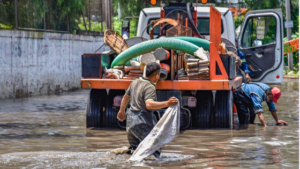Understanding Water Scarcity

Water is essential for all life on Earth, yet it is a resource that is becoming increasingly scarce. According to the latest research by the World Wildlife Fund (WWF), water scarcity is a growing threat that affects people, ecosystems, and economies around the world. This article aims to provide a comprehensive understanding of this urgent issue by exploring its causes, impacts, and potential solutions. Through data and insights from WWF’s global efforts, readers will gain a deeper understanding of the severity of water scarcity and the need for sustainable solutions. By raising awareness and educating others, we can work towards a more water-secure future for all. Let’s delve into the complexities of water scarcity and its impacts, and explore the hope that sustainable solutions can bring.
Understanding Water Scarcity
Water scarcity is a pressing global issue with far-reaching consequences. According to the latest research by WWF, water scarcity is defined as the lack of access to clean and safe water for basic human needs, as well as for agricultural and industrial purposes. It is a result of various factors, including climate change and overconsumption of water resources. To put it into perspective, 2.2 billion people globally do not have access to safe drinking water, and by 2025, half of the world’s population will be living in water-stressed areas. These alarming statistics highlight the urgency of addressing water scarcity.
The root causes of water scarcity, such as climate change and overconsumption, have a significant impact on ecosystems, human health, and economies. This interconnectedness leads to severe consequences, including water pollution, loss of biodiversity, and economic instability. It is crucial to understand the implications of water scarcity, as it affects every aspect of our lives.
Reversing this trend and finding sustainable solutions to address water scarcity is crucial. WWF is actively working towards this goal through initiatives such as promoting water conservation and community-driven projects. By raising awareness and implementing sustainable solutions, we can work towards a future where everyone has access to clean and safe water.
Impacts of Water Scarcity
Water scarcity has far-reaching impacts on ecosystems, human health, and economies. According to the World Wildlife Fund’s (WWF) latest research, over two billion people live in countries experiencing high water stress, and the number is expected to increase. This scarcity has severe implications for the environment as it disrupts natural processes and reduces biodiversity. It also affects human health, with approximately 1.8 billion people at risk of waterborne diseases due to lack of access to clean water. Economically, water scarcity leads to crop failures, loss of livelihoods, and increased food prices.
The interconnectedness of these impacts cannot be ignored. For example, water scarcity can cause conflicts and displacement in areas where water is a limited resource. It also contributes to poverty and inequality, particularly in developing countries. As the water demand continues to rise, the impacts of scarcity will only worsen.
To address these impacts, it is crucial to find sustainable solutions and mitigate the effects of water scarcity. This requires collaboration and action from individuals, communities, and governments. It is essential to raise awareness and take action to ensure a more water-secure future for all.
WWF’s Efforts in Addressing Water Scarcity
WWF is at the forefront of addressing the growing threat of water scarcity. Through various initiatives and partnerships, they are working towards finding sustainable solutions to this pressing issue.
Initiatives and strategies
WWF is taking a multi-faceted approach to address water scarcity. They are implementing conservation measures and working with communities to promote responsible water use. They also collaborate with governments and businesses to influence policies and practices for better water management.
Successful examples
WWF’s efforts have yielded successful results, such as the restoration of the Indus river basin in Pakistan through community-based conservation efforts. They have also worked with Coca-Cola to improve water efficiency in their bottling plants, reducing their water usage by 20%.
Importance of Collaboration
WWF recognizes that addressing water scarcity requires collaboration and partnerships. They work closely with local communities, governments, and businesses to implement effective and sustainable solutions.
By joining forces with WWF, we can strive towards a water-secure future for all.
Sustainable Solutions for Water Scarcity
There is no one-size-fits-all solution to address water scarcity. To combat this pressing issue, we must adopt a holistic approach that includes technological innovations, conservation efforts, and community involvement.
One promising solution is the implementation of sustainable farming practices, such as drip irrigation and crop rotation, which can significantly reduce water usage while maintaining crop yields. Another approach is the use of rainwater harvesting systems, which can provide a reliable source of water for domestic and agricultural use.
Furthermore, community involvement and behavior change are crucial in finding lasting solutions to water scarcity. By promoting water conservation practices and educating individuals on the value of water, we can reduce overconsumption and promote more sustainable water management.
Ultimately, it is important to remember that sustainable solutions for water scarcity require collaboration and cooperation. By working together, we can create a more water-secure future for generations to come.
Hope for a Water-Secure Future
As we have explored, water scarcity is a growing threat with far-reaching consequences. However, there is hope for a more water-secure future through collective action and conscious choices. By adopting sustainable solutions and supporting organizations like WWF in their efforts, we can make a significant impact in mitigating and adapting to water scarcity.
Through innovative conservation approaches and community-driven initiatives, we have seen successful strategies in addressing water scarcity. These efforts not only help to preserve ecosystems and protect human health but also have positive economic impacts. Furthermore, by involving communities and promoting behavior change, we can create a long-lasting and sustainable solution to this crisis.
Together, we can make a difference in securing a water-secure future for generations to come. Let us continue to educate ourselves and others on the causes and impacts of water scarcity, and take action to support sustainable solutions. With determination and collaboration, we can create a world where water scarcity is no longer a threat, but a thing of the past.
Conclusion
In conclusion, water scarcity is a pressing issue with far-reaching consequences for ecosystems, human health, and economies. As discussed in this article, the causes of water scarcity, such as climate change and overconsumption, must be addressed through sustainable solutions to mitigate its impacts. WWF’s latest research sheds light on the urgent need for action and offers hope for a more water-secure future. Through collaboration and partnership, we can adopt innovative approaches and technologies, as well as promote community involvement and behavior change, to ensure a sustainable water supply for current and future generations. Let us take action now and support organizations like WWF in their efforts to address water scarcity and build a brighter future for all.
https://serenity7wellness.com/index.php/2023/12/18/what-is-sustainable-living/
https://www.unicef.org/
https://www.unwater.org/
FAQ’s
Q: What is water scarcity?
A: Water scarcity refers to the lack of sufficient available water resources to meet the demands of water usage within a region. It can be caused by physical scarcity, economic scarcity, or a combination of both.
Q: What are the main causes of water scarcity?
A: The main causes of water scarcity include increasing water consumption, limited water availability, climate change, inadequate water infrastructure, and poor management of water resources.
Q: How does water scarcity impact communities?
A: Water scarcity can have significant impacts on communities, leading to water-related health issues, food and economic insecurity, and conflicts over water resources. It also affects agriculture, industry, and overall sustainable development.
Q: What is the difference between physical and economic water scarcity?
A: Physical water scarcity occurs when the demand for water exceeds the available amount, whereas economic water scarcity refers to the lack of investment and proper management of water resources, resulting in inadequate access to safe water.
Q: How can water scarcity be addressed?
A: Water scarcity can be addressed through sustainable water management practices, improving water infrastructure, promoting water conservation, implementing effective water policies, and enhancing access to safe water sources.







